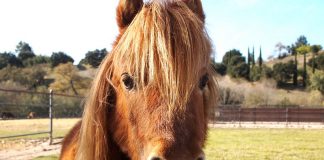
When I was young, we replaced our saintly first horse with a horse that wasn’t so much chestnut as red—the color nature usually reserves for things you shouldn’t eat. Or touch. Or look at funny. And as a fellow redhead, I loved Oliver immediately.

…And this photo collage is proof.

Yes, we are forcing his ears forward.
But when Oliver wasn’t squealing or generally disrespecting your existence, he was fun to jump, supremely comfortable to ride, and above all—an eager, loyal partner. He walked down goofy, unkempt trails without protest. He never refused a fence, boldly taking whatever dummy distance I served him. He nickered when I walked up. He tagged along behind me in the grass. I led him with a lead rope, but it hung loose, draped over my shoulder. I didn’t have to look. He was following me. He wasn’t the ideal hunter I probably wanted, and yes, he taught me to stick a buck, but after a bad fall, the first thing I saw was a red muzzle with a white blaze lumbering toward me, head low, face sheepish.
Like any sane horseperson, I appreciate a kind horse, the soft, nuzzley type that requires no special instructions before you hand the reins to your non-horsey spouse. So chalk it up to how you can tell there’s something going on behind their “Who Me?” eyes, to how worthy you feel once you earn their affection, or to garden-variety masochism—but there’s just something about the ones that are in your business. Once they’re yours, they’re yours.
Oliver had terrible manners (15-year-old me certainly takes some of the blame). He wasn’t perfect. At times, he was evil, and sometimes my mother thought he was a mistake. Yet, while I had casually waved goodbye to our sweet, quiet first horse, I cried the whole drive home when we sold Oliver—and it’s Oliver who still occupies prime real estate in my childhood bedroom.

More than a decade later, I tacked up a gray mare for the first time who was completely in my business. I had just ridden a sweet, quiet chestnut, and now it was time to try the gray to decide which to lease. The chestnut had picked up each hoof before I reached it and lowered her head for brushing. And here was this gray mare. Pushing me around. Investigating my backpack. Eating my shirt. Tasting the brushes. Knocking over the pitchfork. I walked under her neck; she bumped me in the back. She poked me with her face at every opportunity, all eyelashes and swiveling ears. For the love of God, I groaned, just let me groom you. I heard her pawing as I walked away and rolled my eyes. But when I returned with my saddle, I saw her neck craned like a giraffe to look for me. I stopped dead in my tracks, smiled, and thought, Ah. Never mind. I know you.
It’ll be nine months with gray mare tomorrow.
Emily Bogenschutz lives in Texas and is a freelance writer,
recent hunter-turned-jumper, and professional sneaker of saddle pads
into the washing machine. Follow her on Twitter: @EJBog.






why did she sell Oliver?
Hi, Beth! Ah, it was a very standard “we should move you up to a nicer horse” (sigh) moment coupled with a looming college departure date. We ended up leasing a horse for my last half a year or so before college. She was lovely, fun, and objectively fancier–but she wasn’t Oliver.
I don’t understand how horse people just sell their companions. You never know where they end up. It should be a forever home when you aquire a companion pet. Please write more stories in support of lifetime care of these wonderful animals
I often wonder how a person really learns to ride on a horse that presents no challenges. My first horse – when I was 10 – was a 2 year old filly who had not even been halter trained at the time my dad bought her. I think back and marvel that I had no fear at all, and how I learned to stay with the horse that I’m not sure I would have with a staid school horse.